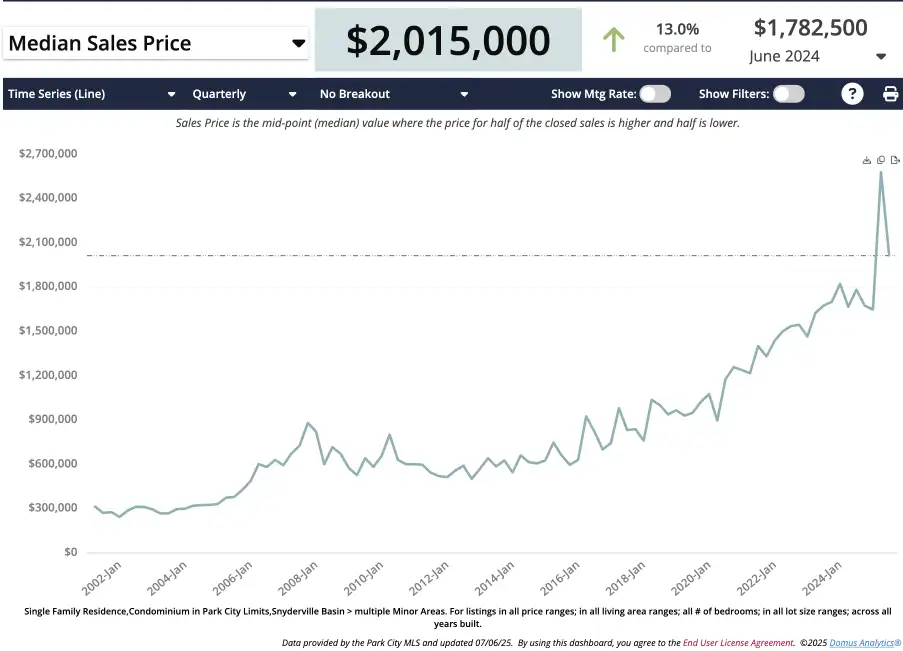The second quarter was certainly remarkable, though not for the reasons we enjoy. Financial uncertainty was the preeminent driving force through this portion of the year. With a first quarter that was moving hot and fast, there was anticipation that we would continue that momentum through the end of ski season; instead, the market largely slammed on the brakes. Uncertainty is anathema to a healthy, thriving market in any class or segment.
April typically brings a slowdown in showing activity and transactional activity as our town transitions from a winter destination to a world-class summer destination – restaurants shut briefly, people begin to focus on the end of school, and activity wanes. 2025 had our seasonal slowdown paired with “tariff uncertainty,” which led to enormous ripple effects on the financial markets and, by default, our real estate market.
The good news in all of this is that it may be short-lived. It appears that at the end of the quarter, we were moving out of this lurch with a delayed summer market finally picking up steam. Inflation concerns appear to be allayed with potential rate cuts in the pipeline, giving us optimism moving forward. With some stability, transactional activity is coming back and bodes well; however, let’s take a look at the key metrics from the quarter.
Key Sales Metrics (Overall Park City Market)
Median Sales Price
$2,015,000, up 15% from the same quarter last year
Average Sales Price
$3,165,867, up 24.6% from the same quarter last year
Closed Sales
224, down 5.2% from the same quarter last year
New Properties Listed
475, up 11% from the same quarter last year
Q2 2025 Park City Real Estate Sales Metrics Overview
Pricing remains quite high. As you can see from the charts below, our median and average prices remain well above historical averages, illustrating that the top-end, luxury segment was strong. This makes sense as that type of buyer tends to be more insulated against the short-term volatility in the economy. The majority of that inventory is also new construction, which is very attractive for a number of reasons.

There are a few interesting metrics here. I want to touch on closed sales first. Typically, each year Q2 has higher sales volume than Q1; that has been true every year with the following exceptions.
- 2003 – Post-Olympic slowdown
- 2006 – Multiple new construction projects finishing in Q1
- 2020 – Covid making its mark in March of 20
- 2022 – Market “peak”
- 2025 – Tariff market
2025 Real Estate Market Trends
Now, this is not indicative of larger trends. Both in 2003 and 2020, the following quarters’ transactional volume began to ramp up. It is more to illustrate that significant events regarding the economy can lead to a slowdown in activity during a quarter when you would expect increased volume.

The economic volatility truly caused a pause in the real estate market, one where pricing wasn’t as useful a lever as it usually is, because buyers didn’t know what was going to happen. Since then, though, as everything has come back to life, the market has certainly been recalibrated with buyers holding more of the leverage and sellers needing to adjust to that new reality – one in which pricing is more important than it has been in years. What we saw in quarter two was that, on average, a property would sell for 95.4% of list price, which is a touch lower than the historical average, as more transactions feature wider negotiations.
Interestingly enough, we can look at 2024 for a bit of guidance, as the trajectory we are seeing is similar to last year’s. If you recall, the first quarter of 2024 was on a tear; the anticipation and projections from major financial institutions were for as many as five rate cuts. Inflation had other ideas and stuck around much longer than anticipated, which led to higher rates for longer and caused a slower than anticipated second quarter. The summer market was also delayed, and with a looming election was also a bit shorter than usual.
All signs are pointing towards July and August leading the way for a strong third quarter as buyers come back to the market. The sellers that are successful are going to be well-positioned in both price and product, and will need to be negotiable as we navigate a market tilted in favor of buyers.
The Park City market is highly segmented. If there is any specific area or neighborhood you would like to know more about, or if you want to get into the nitty gritty statistics, please reach out!